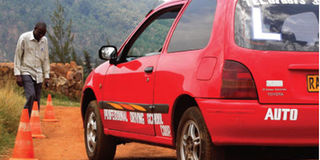What it will take to accelerate progress on road safety

A learner practises for the Rwandan driving test. PHOTO | FILE
What you need to know:
- First and above all, they make sure no one is licensed to drive a vehicle until they have been thoroughly trained to a very high standard, and rigorously tested.
- If you have good drivers, every other challenge in the matrix of roads and vehicles and traffic is dramatically reduced.
If you questioned the people who make and enforce Kenya’s traffic laws on their “vision” for road transport, their answer would be unanimous: safe, efficient and economical mobility based on competent drivers using roadworthy vehicles on quality roads.
Well here’s the news. That is exactly what motorists want, too. So why are the two sides at such loggerheads, with one side calling the other “cheating hooligans!” and being answered with “thieving bullies!”
I am not suggesting either of those accusations is true (perish the thought!); merely characterising what seems to be a relationship of profound mutual disrespect. If they really did have the same goal, this would not happen. People with a common cause are not opponents; they’re allies.
That doesn’t mean road governance has to get soft. On the contrary. In countries where the relationship between motorists and police is most harmonious (and hence where compliance with the law is highest) the rules and enforcement are extremely strict.
But they are fair. They are honest. They are reasonable. And by far the strictest rules apply to the policy makers, the law makers, the law enforcers, and the road administrators themselves. And their highest priority is to ensure that motorists can, and want to, comply.
First and above all, they make sure no one is licensed to drive a vehicle until they have been thoroughly trained to a very high standard, and rigorously tested. If you have good drivers, every other challenge in the matrix of roads and vehicles and traffic is dramatically reduced.
Second, they provide decent roads – not all superhighways, but all reasonably built, diligently maintained and near perfectly signposted and marked…by people who know how to do that, and make sure it is done properly.
Third, they ensure that every vehicle arriving on those roads starts in new or good-as-new condition. And because the roads are good and the drivers are competent, and both service agents and parts suppliers are subject to stringent standards, those vehicles suffer minimal wear and tear, are regularly serviced and checked, and so they very rarely develop safety-critical defects.
Fourth, administrators are strict on every detail, but draw clear distinction between faults that are paper-technical, and those which are socially disruptive or physically dangerous. The law and the enforcers show respect for motorists, and they get respect in return.
Where an unacceptable pattern of conduct or practice emerges, remedy starts with public education campaigns, guidelines, and enabling measures. Administrators do all they can to help motorists comply before punishing them for failing to comply.
Yes, vehicles are “inspected” – as part of the incentive to replace with new before a vehicle goes beyond its viable design life. But the inspection is done by private sector workshops that are also equipped to fix faults. Officials inspect the workshops; independent mechanics inspect the vehicles...during routine service.
No motorist anywhere drives a defective car because s/he wants to. Either they don’t know its faulty, or can’t find anyone to fix it, or cannot afford the necessary replacement parts.
How does “inspection” or “punishment” solve any of those problems? It doesn’t. Public education, non-damaging roads, higher parts and workshop standards, respect for the law (on both sides), and lower tax on quality parts do. We would do well to emulate that approach – in the right order of priority.





